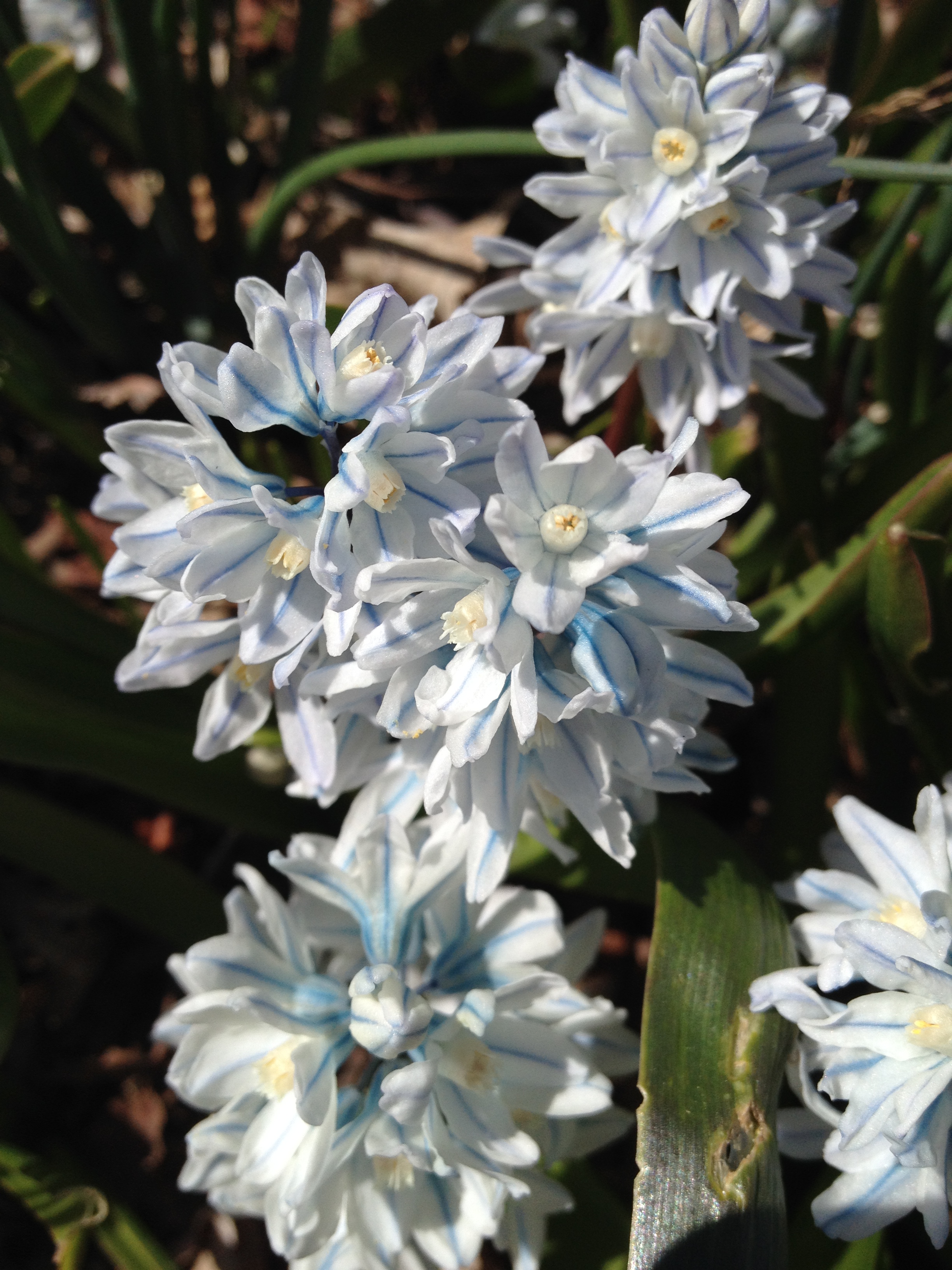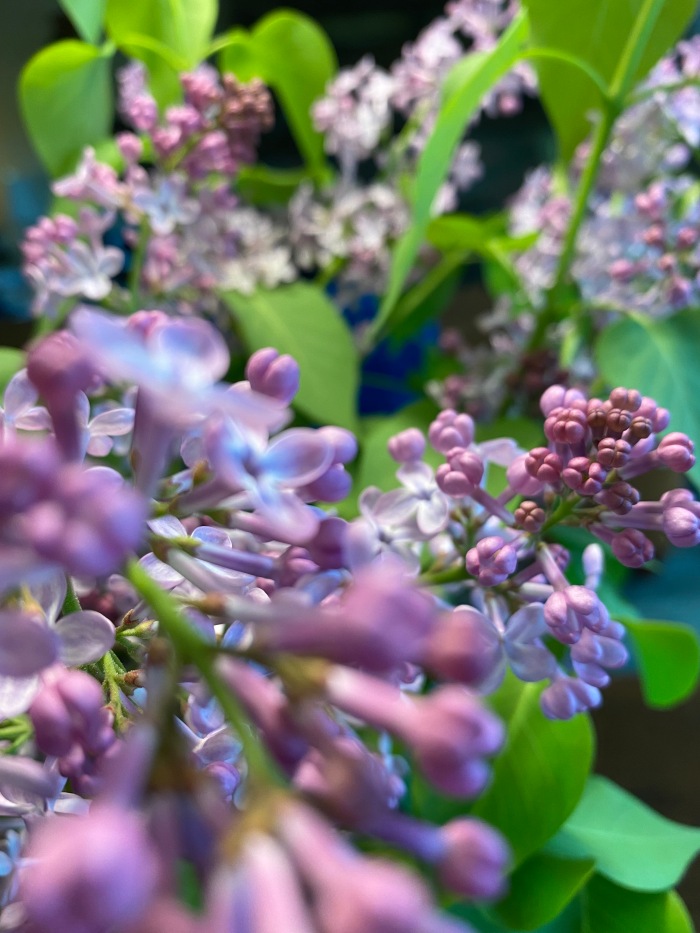Hallelujah! Spring has officially sprung. Ok, it’s tomorrow but my patience for the return of sunny skies and warmer temperatures has run thin. In celebration, I’d like to share some of my favourite spring plant stars. These 6 spring flowering plants are dear to my heart because of their lovely colours–shades from dusky to brilliant but all a reflection of spring’s glorious blue skies.
Iris reticulata


I’m cheating a little here as it’s obvious these little beauties (above) aren’t growing in the garden but on my kitchen windowsill. I just couldn’t resist their promise of spring even though these photos were shot in mid-January. Iris reticulata are a true delight in the early spring garden, often pushing up through the last bits of snow from March to April. Though they look purple in these photos, I find that when the sun is just right, they glow a heavenly sky blue.
Best unexpected bonuses:
- They have a beautiful fragrance which, if they are growing outside in your garden, you have to get down in the spring damp on your hands and knees to appreciate. If that doesn’t appeal, I recommend you go the forced-blubs-on-the-windowsill approach.
- They prefer a pretty dry situation throughout the summer in order for the bulbs to set new buds for the following year. So put them in a part of the garden that catches your eye in the spring but that you have every intention of neglecting later on. Win-win.
Puschkinia


These delicate flowers have to bear the weight of one tongue-twister of a name: Puschkinia scilloides var. libanotica. Its common name, Striped Squill, maybe shorter but it’s no prettier. What it does have going for it is masses of tiny white, star-shaped blooms, each striped in an extraordinary Robin’s egg blue that pop out in late winter to early spring.
Best unexpected bonuses:
- These lovelies are another reason you’ll be crawling around in the spring mud. They also have an exquisite fragrance.
- They naturalize pretty easily and can look spectacular planted en masse in a woodland garden or a rockery.
- If you really want to highlight their blue-ness, pair them with other early blooming, short-statured plants in a mixture of warm yellows such as Golden Yellow Crocus and dwarf daffodils.
Lilacs

Lilacs are usually lilac-coloured, as in mauve or purple, but sometimes you can stumble upon a lilac bloom with a teasing hint of blue. Every spring, about mid-May, I strike out with gardening shears in hand to my favourite (and top secret) wild lilac spots near our cottage on the Bruce Peninsula in Ontario. There’s one very special shrub I discovered years ago, down a narrow farmer’s track, that reliably blooms with blue-tinged flowers.
Best unexpected bonuses:
- Lilac shrubs are traditionally a sign of welcome. Even though lilacs seem to grow wild all over the southern half of The Bruce, they’re actually here thanks to early farming settlers who brought the plants with them from Europe. I’ve heard it said that if you discover a grouping of lilacs in the area, there’s a good chance you’re actually treading over the remains of an old farmstead. A tightly knit grouping of lilacs can reliably indicate where a farmhouse front door used to be.
- Lilacs take well to pruning and as they can grow into tall, leggy shrubs, they can make a terrific privacy shrub with plenty of room under their arching bows for shade-tolerant perennials.
If you happen to be in Ontario in late May, try to visit the Katie Osborne Lilac Garden at the Royal Botanical Garden in Burlington (shown below). The garden is home to one of the largest and most diverse lilac collections in the world. The lilac dell is like a sweeping natural amphitheatre, filled with lilac shrubs. When they’re all in full bloom, the effect is transportive.





Irises

I think this is one of those weird situations when you photograph something blue and the resulting image has a purple tinge like the one above. Trust me, Canadian Kisses (shown above), a standard dwarf bearded iris is very definitely blue–as blue as Paul Newman’s eyes. I love the way the iris’ “beard” accents that blue with a shocking jolt of gold.
Best unexpected bonuses:
- Standard dwarf bearded irises, like Canadian Kisses, bloom a good month earlier than their well-known cousins, the tall bearded irises. So if you plant dwarf irises as well as tall irises, you get an extended, two-month show of colour as well as a slowly evolving show of height from short to tall over the season.
- Irises famously grow in clumps that need to be lifted and divided every 3 or 4 years. But if you’re impatient, you can get those big clumps faster by planting up to 3 iris rhizomes in the same hole and they’ll knit together.
Blue-Eyed Grass


Common Blue-eyed Grass (Sisyrinchium montanum) is a native wildflower to pretty much all of southern Canada and northern United States. They appear as spring melts into summer (April/May/June). Although their leaves look very grass-like and despite their name, they’re actually a part of the iris family. The photos above were taken at the Oliphant fen, one of my favourite places to spot Ontario wildflowers. And, yes, they can be bought through reputable garden centres specializing in native plants.
Best unexpected bonuses:
- These gorgeous beauties thrive in both dry and moist soil so if you have a spot in your garden that doesn’t have great drainage or occasionally gets flooded, consider these as the wonderful start to a charming wild meadow-themed bed. They also take well to container growing–a great alternative to easily maintain soil moisture.
- If you want to create a prairie-like garden, filled with wildflowers, but you want to keep your plants on the short side, this is the flower for you. Most prairie wildflowers grow on the tall side but these beauties range from about 8 to 20 inches tall. Because of their shorter stature, they’re also great in rock gardens or small woodland-themed gardens although you’d need to place them in the one patch of the garden that gets plenty of sunlight.
Brunnera

I love this plant at any time of the growing season but I’ve got a real soft spot for it in mid-spring. Brunnera macrophylla, shown above, is generally regarded as an outstanding show plant for the shade and woodland garden because of its leathery leaves handsomely spangled in light-catching silver not unlike what a fashionable medieval knight might flaunt. But, come spring, it nonetheless produces these adorable little cutie-pie blooms–small, soft and cheerful–that seem in absolute defiance of its large, rough and vaguely menacing leaves. Those flowers always bring a smile to my face.
Best unexpected bonuses:
- Brunnera can grow in full shade and look lovely grown in masses as a sumptuous and eye-catching (albeit tall-ish) ground cover in hard-to-grow spots under trees.
- If you’re into the silvery look, try Brunnera ‘Jack Frost’ which is really breathtaking. Pair it with Japanese painted fern (Athyrium niponicum) for a truly shimmering sight.
What are your favourite spring flowers? True blue isn’t always an easy flower colour to find. I’d love to know about some of your tried-and-blue faves.




Pingback: Here comes summer 10 ways | Ministry of the fence